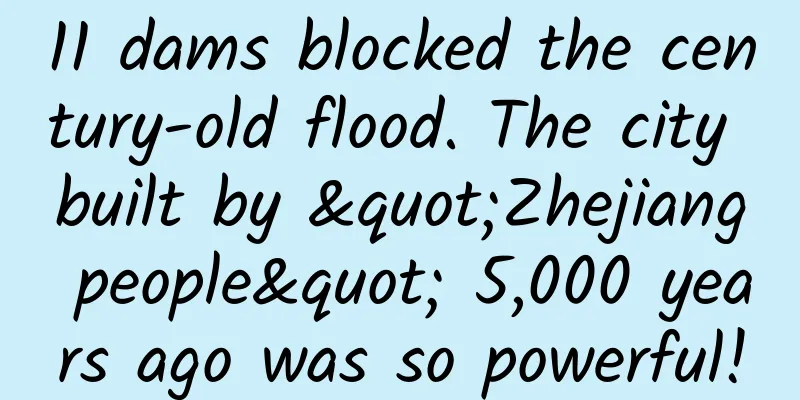11 dams blocked the century-old flood. The city built by "Zhejiang people" 5,000 years ago was so powerful!

|
More than 5,000 years ago, the wise Liangzhu people were born in Taihu Lake, formerly known as "Zhenze" in the middle and lower reaches of the Yangtze River. Eight years ago, the country's top archaeological experts and water conservancy experts held an expert discussion meeting on the water conservancy system outside the Liangzhu ancient city in Hangzhou, and concluded that the water conservancy system outside the Liangzhu ancient city is the earliest large-scale water conservancy project in China so far, and also the earliest dam system in the world. The design area exceeds 100 square kilometers, which once again proves that the Liangzhu ancient city has a complete capital structure, from the inside to the outside, it is the palace city, the royal city, the outer city and the peripheral water conservancy system. The expert said: "Water conservancy projects of more than 100 square kilometers are rare in the world. The water conservancy system outside the Liangzhu ancient city is not only of historical significance, but also a major scientific and technological discovery in the world." Before that, our understanding of China's water conservancy history was still about Dayu's flood control about 4,000 years ago. However, this was just a legend, while the Liangzhu water conservancy system is "conclusive evidence." 11 high and low dams to withstand a once-in-a-century flood For ordinary people, if they want to understand the Liangzhu water conservancy system, there are two places they must visit - Liangzhu Museum and Laohuling Ruins Park. Although it was a weekday morning, the Liangzhu Museum was still crowded with visitors. Walking into the entrance of the exhibition hall of the holy land of civilization, what caught my eye was the replica sand table of the Liangzhu ancient city. The center of the ancient city was the high-raised Mojiao Mountain Palace area, and the eastern part was where the Liangzhu people lived and farmed for generations. The water system inside the city was in the shape of a "工" character, and outside the city were intertwined rivers. The internal and external water systems were interconnected, and the entire ancient city system was fully in line with the shape of the mountains and the water. Mr. Ma, an interpreter at the Liangzhu Museum, said: "The location of the ancient city is very particular. It is at the junction of the mountains and plains, backed by the resource-rich Tianmu Mountain hills, and the developed water system is connected to the vast river network of Taihu Lake, thus forming an ancient city with convenient transportation and rich resources." Liangzhu Ancient City Replica Sand Table The people living in the Liangzhu ancient city depend on water for their livelihood. The Taihu Plain where they live has an altitude of only 2 meters. Tianmu Mountain is the center of heavy rain in Zhejiang Province. Mountain torrents are easily formed during the monsoon season every year. Once a flood comes, houses are easily flooded. Therefore, in order to protect themselves, the Liangzhu people must build dams to block the floods. In order to resist floods, the clever Liangzhu people planned a complex water conservancy system. The archaeological team found that there were 11 dams in the water system outside Liangzhu City. According to the different locations and shapes of these dams, they can be divided into three types: high dams at the mouth of the valley, low dams on the plains connecting the hills, and long dams in front of the mountains. Six high dams, including Laohuling, Zhoujiapan, and Qiuwu, were mainly built between the valleys in the east and west to block the water in the valleys. The four low dams, Wutongnong, Guanshan, Liyushan, and Shizishan, connected the small hills on the plains. This area just formed a secondary reservoir with an area of up to 9 square kilometers. After analysis by experts from the Institute of Archaeology of the Chinese Academy of Social Sciences, it was found that these dams can block 960 mm of continuous precipitation in a short period of time, which is equivalent to resisting a once-in-a-century flood in the region. During the calm period of the river, the water blocked in the dam can be used to irrigate farmland, and the river connected to the dam can be used to transport goods to meet the daily travel needs of the Liangzhu people. Some experts have calculated that when it is full of water, it is possible to sail up the valley for about 1,500 meters. The water conservancy system designed and constructed by the Liangzhu people 5,000 years ago under the productivity conditions of the time was impressive for its broad planning vision, high technical level, and strong organizational ability. The Liangzhu people's experience in water management laid the foundation for the living model of the Jiangnan water town Laohuling Dam Site The Laohuling Ruins Park, 15 kilometers away from the Liangzhu Museum, presents a picture of late autumn in the south of the Yangtze River. Walking along the winding path, through a rice field, and climbing up the stairs, a huge white teardrop-shaped building came into view. This is the original site of the Laohuling Dam. Entering the exhibition hall, standing in front of the reporter is a loess dam body about 15 meters high. The reporter carefully looked at the remains of the Tiger Ridge Dam. According to the cross-section of the dam, the dam is mainly made of staggered and stacked blocks, which is the "mud wrapped in grass" created by the Liangzhu people. The homes of the Liangzhu people were right next to the swamps. There was silt under the swamps, and grass, including reeds, reeds, and thatch, grew on top. The Liangzhu people first cut the grass on the ground, cut the silt under the grass with a shovel, rolled it on the grass, wrapped it with silt, and tied it with reeds. The raw materials for building the dam were formed. In this way, they shoveled silt and cut grass all the way, and the land they passed through slowly became a river. They then drove their own small bamboo rafts over, put in these raw materials, and then relied on the human sea tactics to build the dam in a team-passing manner. The haystack and mud-inserting tools used to make the grass-wrapped mud Can these embankments made of only grass and soil really withstand the strong erosion of floods? After recreating the scene 5,000 years ago for the reporter, Wang Ningyuan, director of the Science and Technology Archaeology Office of the Zhejiang Provincial Institute of Cultural Relics and Archaeology and archaeological leader of the Liangzhu Ancient City and Water Conservancy System Project, said: "The grass-wrapped mud itself is small, soft, and has good plasticity. It fits tightly with the grass stems outside, so after being piled up, it fits tightly and will not leak at all." After exploration, the archaeological team discovered that the grass-wrapped mud on the dam were all placed close to the water diversion surface and close to the location where the flood force was relatively large, and its role in flood prevention was obvious. The artificial dam in Liangzhu is not only for flood control, but also for daily travel. A large bamboo raft is made of about 20 bamboos woven together. A raft can seat about 10 people, which is very suitable for a large family or several families to travel together. Some Liangzhu people may prefer canoes to enjoy the happiness of being alone. "The Liangzhu people's experience in water control should have left traces in the water control legend system." Wang Ningyuan said, "From the dam system of the Liangzhu ancient city, the many high dams in the valleys are simple interception dams; the low dams in the south are also designed to keep the water from the northwest mountains in the depressions, which is called '壅防'; and the houses of the Liangzhu people are basically built in the swamps, which is '堙庳 (pronounced yīn bì)'. The characteristics of Liangzhu settlements are very similar to those of Jiangnan today. Therefore, the living pattern of Jiangnan water towns was established by Liangzhu people and has not changed in 5,000 years." Expert Interview Liu Bin, the discoverer of the Liangzhu ancient city ruins: Urban planning 5,000 years ago was already scientifically forward-looking In July 2019, the Liangzhu Ancient City Site was included in the World Heritage List. One of the reasons for the inclusion was that Liangzhu already had an "early regional state form", highlighting Liangzhu's outstanding contribution to the development of Chinese civilization and even human civilization. How does the Liangzhu site verify the 5,000-year history of Chinese civilization? In what aspects is the wisdom of the Liangzhu ancestors reflected? Liu Bin, professor of the School of Art and Archaeology of Zhejiang University, director of the Art and Archaeology Museum of Zhejiang University, former director of the Zhejiang Provincial Institute of Cultural Relics and Archaeology, and discoverer of the Liangzhu Ancient City Site, is a guest on this issue of "Science in Zhejiang Culture". Question: What is the scientific significance of the discovery of Liangzhu culture? A: Liangzhu culture, dating back 5300-4300 years, can be said to be one of the most convincing evidences of China's 5,000-year history of civilization. In particular, the Liangzhu ancient city discovered since 2007 and the large-scale water conservancy system outside the ancient city confirmed in 2015, from the aspects of urban planning, urban scale, social hierarchy, and productivity development level, all indicate that China had entered the stage of national and scientific civilization at that time. Question: What scientific considerations were reflected in the water conservancy achievements of the Liangzhu ancestors? Answer: Because the whole city was built on swampy land, in order to block water infiltration and prevent the foundation from becoming soft, the bottom was first paved with stones mined from distant mountains, and then yellow clay was piled up on the top. In addition, a land gate and eight water gates were designed inside and outside the city to connect with the city river. The Liangzhu people built a high platform on Mojiao Mountain that is more than 600 meters from east to west, more than 400 meters from north to south, and more than ten meters high. In order to reach a certain height, the Liangzhu ancestors cleverly used the natural mountains in the west. On this basis, they piled up the low-lying areas in the east with ash silt and grass-wrapped mud, and then piled it with loess and reinforced the edges. In the construction of the dam, they would first dig a trench along the direction of the dam, and then fill it inward. This technology can prevent leakage and make the dam more stable. Question: What special building materials did the Liangzhu ancestors use during the construction of the dam? Answer: One is yellow clay, which is also used in the city walls and the upper layers of the palace. Until now, local people still use this clay to build river embankments and dams. This soil has strong viscosity, but it is very hard after drying, so it is an ideal material. The other is grass-wrapped mud, which is also a more clever way for Liangzhu to build dams and large earth platforms. They use mud from swamps and then tie it with thatch, reeds and other plants. After it is done, it is transported over, and it is stacked horizontally and vertically to increase strength. Because grass-wrapped mud can be prefabricated, Liangzhu people can not only obtain materials locally, but also transport them from Shanghai, Suzhou and other places. Question: What is the significance of the construction of the dam to the Liangzhu ancient city? A: The most important thing is to prevent floods in the rainy season, so that the Liangzhu ancient city located in the plain can avoid the destructive impact of mountain torrents. At the same time, it also has the effect of water storage and irrigation. Another function is transportation. After the dam is built, it can connect multiple valleys to form a water transportation network to facilitate transportation. Farming tools used by Liangzhu people: stone plow Q: In addition to construction engineering, were there any other amazing scientific and technological achievements during the Liangzhu period? A: Liangzhu culture is worthy of praise in many aspects. First of all, the overall design of Liangzhu's urban planning layout well reflects the wisdom of the ancients, such as the location of the city, the triple structure of the palace area, the inner city, and the outer city, the relationship between the city and water conservancy, etc. This urban planning awareness is quite forward-looking; secondly, Liangzhu's rice farming was very developed. The stone sickles at that time were no different from today, and it is inferred that plow farming was adopted, which marked a great progress in agriculture. The large area of Liangzhu's rice fields and the large number of carbonized rice also confirmed the high level of agricultural production at that time; Liangzhu also made significant breakthroughs in astronomical observation, jade production, primitive writing, etc., all of which show that Liangzhu was already in the civilization stage. |
<<: Sea buckthorn, how to make the desert green and golden?
Recommend
The science behind mutual attraction
Usually, when we fall in love with someone, it se...
Example analysis: How to write a product data report?
Product data reporting is an essential task for p...
In-depth optimization and production practice of Flink engine in Kuaishou
Abstract: This article is compiled from the speec...
Are the products on Taobao’s daily specials genuine? How can I participate?
The prices on Taobao’s daily specials are very ch...
Regarding travel during the Mid-Autumn Festival! The Ministry of Culture and Tourism issued a reminder
The 2024 Mid-Autumn Festival holiday is approachi...
Why are these two cabinets called the "guardians" of scientific experiments on the space station?
Produced by: Science Popularization China Author:...
In the battle of short video platforms, can Haokan Video make up for the shortcomings in content quality?
Short videos are a black hole for netizens' t...
Qualcomm: Android phone users will be able to use face recognition next year
According to 9To5Mac on August 15 Beijing time, t...
Does the death of Qvod P2P have anything to do with porn trafficking?
This week, Kuaibo, which was supposed to be compl...
Kuaishou beauty industry advertising research report!
Paying for beauty has become a daily routine for ...
A must-see for bosses/directors! 18 cheating tricks for Internet marketing
Practitioners of online advertising in China all ...
Sudden weight gain? It could be due to lack of sleep
Why do I gain weight even though I don’t feel lik...
What happened to those who loved drinking sparkling water?
In recent years, sparkling water has become incre...
Where to buy Qunar? How to use vouchers to attract new users and promote their activation?
There is less than a month left until Chinese Val...
Why do more people with lung cancer get worse in winter? How can lung cancer patients spend the winter safely? Pay attention to these 6 details
Winter is the most difficult season for lung canc...









